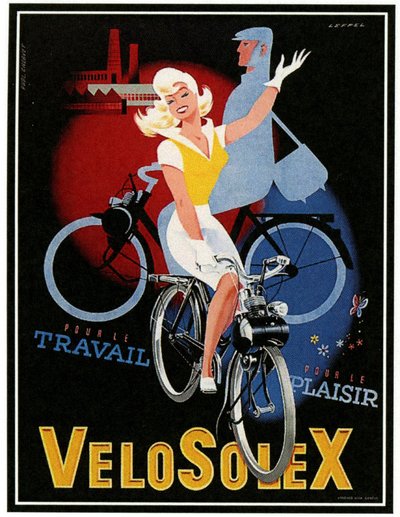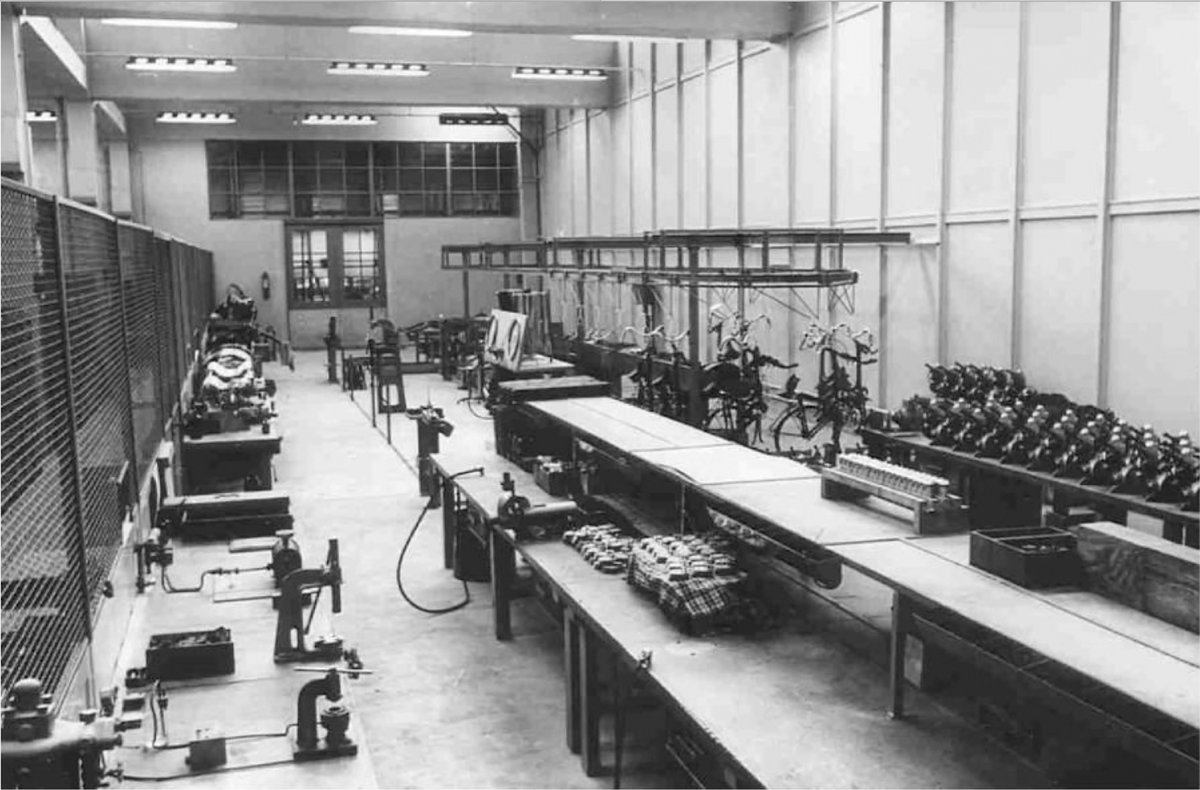Ride in peace!
Velosolex – a phoenix from the ashes
von Heini Hofmann
With today’s bicycle and e-bike boom, people forget that the road to self-propelled bicycles was long. The invention of the cultic Velosolex, which is still popular today, proved to be a great moment in the misery of wartime. This Cinderella story is still regarded as an exemplar of far-sighted corporate strategy.
As early as 1895 the French inventor René Gillet had the idea of mounting a motor on the front wheel of a bicycle. While two-stroke engines and friction roller drives were still suspect to German technicians, the spark ignited in France. In 1901 the Ixion, a bicycle with two-stroke front-wheel drive, was created here. Soon German two-wheelers were also equipped with it (Sigurd) or built under licence in the Komet factories. The Ixion was followed a good decade later, also in France, by the Cyclotracteur with a four-stroke auxiliary engine, which was also used abroad. But the big breakthrough was still to come.
Need is the mother of invention
But the real breakthrough for the self-propelled bicycle came – not by chance – during the Second World War: two young Parisian entrepreneurs, Maurice Goudard and Marcel Mennesson, built radial radiators in their company to cool buses and trucks, and later produced carburettors under the name Solex.
This Solex brand name is later transferred to their bicycle factory, another pillar of their company. Since as from 1940 onwards, the prototype of a self-propelled bicycle with a 2-stroke engine, flanged over the front wheel on an ordinary Alcyon men’s bicycle frame, and equipped with 700 mm wheels (French patent 1941, US patent 1942) was created.
Despite the war situation, the company acted with foresight and a long-term perspective: the first 700 prototypes were distributed to the factory workers from 1942 onwards to test and improve them. This serious approach pays off! For example, it turns out that the standard bicycle frames are not strong enough for the installation of an auxiliary engine in continuous operation, for what reason it is replaced by a more stable, “open” and also women-friendly gooseneck frame (Col de Cygne).
1946 first Velosolex series
The Solexstory is an exemplar of skilful corporate tactics: in the difficult post-war period – in the sense of a popular, reasonably priced means of transport – the engine capacity is limited to 45 cc, an output of 0.4 hp at 2,000 rpm and a consumption of only one litre of fuel per 100 km with a total weight of 25 kg and a speed of 28 km/h. This opens up the Solex to the French cyclomoteurs class, which at that time did not require registration or a driving licence.
In 1946 the factory in Paris-Courbevoie launched the first series Velosolex 650 (2-stroke idler piston engine and power transmission to the front wheel by means of carbon friction rollers) as an additional mainstay, with a daily production of 15 units. The global triumphant progress has begun. But despite success where idealism is at work, there is constant experimentation and improvement.
Thus, in 1947 a long list of newly modified series begins, whereby the proven basic principle always remains the same, as much as does the cultic black paint: “Le noir c’est triste, c’est ça qui est drôle”. With each new series, the daily production increases rapidly. The Velosolex becomes the French savoir vivre in bicycle design – analogous to Citroën’s 2CV (coined Tin Snail or the duck) in car design!
Export, licence and imitation
Also from 1947, and at the request of the Solex company, British Petroleum (BP), to refuel the Solex with the premix product Solexin (94% petrol plus 6% energol oil) in yellow-green 2-litre metal cans was made easier.
Licensees and imitators are finding what is successful. Licensed operations outside France are springing up mushroom-like in the Netherlands, the UK, Poland, Denmark, Italy, Latvia, Germany, and Switzerland (see box). Assembly lines are being set up in Cyprus, Finland, Greece, and Ireland. And from 1974 onwards there are special export models even for Canada, the USA and Brazil, among others.
But competition appears also. In 1958, in the north of France the VéloVap is developed with more power, a sky blue frame and white wall tyres, which was more refined than “the little black Solex horse”. In the same year, also in the north of France, the Flandria Galet follows, which looks similar to the Solex with black frame colour, but is also designed as a coloured luxury version for the Benelux countries.
The end of the Solex fairytale
But the good old self-propelled Velosolex knows how to hold its own, continues to optimise itself and remains full of ideas: smaller wheels for greater driving safety, improved performance and an increase in speed to 30 km/h, special versions such as light three-wheeled delivery van models and with the F4, a mini-bike for children with a noise-generating plastic motor dummy. In 1965, even the standard colour was given competition. The Solex 3800 series not only came in black, but also in white or red.
But every fairy tale has an end – even that of the cheapest motorisation of the post-war period. More than forty years after the first series in Courbevoie (1946), the original Velosolex production in France ends in Saint-Quentin in November 1988. The last one hundred copies are sold to enthusiasts as the Nostalgia model. It is not exactly known how many of these icons were built in total; there are said to be well over six million (worldwide even over eight).
Only the E-Solex was a flop
After the sale of the Solex company, the cult vehicle is still being built, but loses its nimbus because it is no longer the original. The Black’n Roll version made in China became famous. And then something strange happens. In 2005, the Groupe Cible in Paris announces the market launch of an electrically powered e-Solex (lithium-ion battery, 30 km/h, 35 kg), but with a wheel hub motor at the back and only a dummy motor at the front … The target audience is young, urban and female.
But despite the smart red elements in the basic colour black, this e-Solex remains a flop - which is surprising in view of the current e-bike boom. This is probably because the innovation was too futuristic and thus not compatible with the nostalgic feelings of the dyed-in-the-wool original Solexes. Even technical inventions must arouse emotions if they are to be successful.
The Brigitte Bardot Effect
But all in all, the Velosolex, like phoenix from the ashes of wartime, wrote a technical fairy tale as if from the Arabian Nights. What the old aunt Junkers Ju-52 is among the airplanes or the jeep among the off-road vehicles, the Solex is among the bicycles: an icon, with French charm. Popular with everyone, driven by workers and students, priests and professors, farmers and film idols like Brigitte Bardot, who triggered a real boom, but also Charles Aznavour, Jacques Tati or Steve McQueen. (The writer of this epistle has also been driving a solex for over fifty years, and was never let down by it!)
Velosolex stands for a form of locomotion in which speed is not the measure of all things. This is documented by such famous slogans as “Ride in peace”, “La bicyclette qui roule toute seule”, “Freedom and Postwar Mobility”, “Pour le travail et le plaisir”, “For handsome guys and smart bees”, “Passe partout, même dans la boue (dirt)”. Its strengths are: a simple and robust construction, hardly susceptible to breakdowns, roadworthy due to moderate speed, lightness and low price.
In addition, the Solex is versatile: it made history at the post office in France and Switzerland as a postman’s bicycle, but also as a midwife’s bicycle, as the tennis champion prize in Roland-Garros and even in the military during the Vietnam War. In this country, it was affectionately called a nose-warmer bike (because of the engine positioned at the front) and, because some monasteries used it as a service vehicle, “Christian persecutor” or “Maria Hilf” engine. Which brings us to the conclusion of the title: Ride in peace! •
(Translation Current Concerns)
Solex-Special case Switzerland
hh. The federal road traffic legislation was less favourable to the cult vehicle than that of its country of origin, France, where 14-year-olds were already allowed to drive a Solex without a licence. A 1947 decision of the Federal Council placed the bicycle with auxiliary engine in the category of motor vehicles, although the Solex is much closer to a bicycle than a motorcycle. This had negative consequences for the less well-off population, but also for tourism, cross-border workers and hospitality in general, as Solex riders from France and Italy were not allowed to cross the Swiss border.
The Geneva-based company Hispano Suiza, which assembled around 15,000 Velosolexes between 1948 and 1957 using components from Switzerland, was also affected. In view of the International Road Conference to be held in Geneva in 1949, there was resistance in the media and from experts with facts (e.g. that the number of accidents involving motor-assisted bicycles was lower than with normal bicycles). The result was a new Federal Council decision in 1950, which was somewhat more generous but still more restrictive than on the other side of the border.

